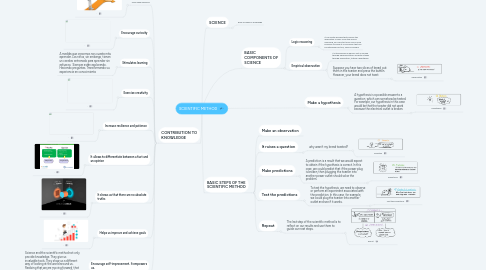
1. CONTRIBUTION TO KNOWLEDGE
1.1. Help make decisions
1.1.1. .
1.2. Encourage curiosity
1.2.1. .
1.3. Stimulates learning
1.3.1. A medida que crecemos nos cuesta más aprender. Los niños, sin embargo, tienen un cerebro entrenado para aprender sin esfuerzo. Siempre están explorando. Haciendo preguntas. Transformando su experiencia en conocimiento
1.4. Exercise creativity
1.4.1. .
1.5. Increase resilience and patience
1.5.1. .
1.6. It allows to differentiate between a fact and an opinion
1.6.1. .
1.7. It shows us that there are no absolute truths
1.7.1. .
1.8. Helps us improve and achieve goals
1.8.1. .
1.9. Encourage self-improvement. It empowers us.
1.9.1. Science and the scientific method not only provide knowledge. They give us invaluable tools. They show us a different way of looking at the world around us. Realizing that we are moving forward, that we are capable of problem solving, that we are finding answers to our questions is a tremendously powerful feeling.
2. Make a hypothesis
2.1. A hypothesis is a possible answer to a question, which can somehow be tested. For example, our hypothesis in this case would be that the toaster did not work because the electrical outlet is broken.
2.1.1. Hypothesis
3. SCIENCE
3.1. Body of ideas or knowledge
4. BASIC COMPONENTS OF SCIENCE
4.1. Logic reasoning
4.1.1. it is a mental process that involves the application of logic. From this kind of reasoning, you can start from one or more premises to arrive at a conclusion that can be determined as true, false or possible.
4.2. Empirical observation
4.2.1. It is the process in which a fact is verified through experimentation and data is taken through observation, testing a hypothesis.
4.2.2. Suppose you have two slices of bread, put them in the toaster and press the button. However, your bread does not toast
4.2.2.1. Observation
5. BASIC STEPS OF THE SCIENTIFIC METHOD
5.1. Make an observation
5.2. It raises a question
5.2.1. why wasn't my bread toasted?
5.2.1.1. Question
5.3. Make predictions
5.3.1. A prediction is a result that we would expect to obtain if the hypothesis is correct. In this case, we could predict that if the power plug is broken, then plugging the toaster into another power outlet should solve the problem.
5.3.1.1. Predictions
5.4. Test the predictions
5.4.1. To test the hypothesis, we need to observe or perform an experiment associated with the prediction. In this case, for example, we could plug the toaster into another outlet and see if it works.
5.4.1.1. Test the Predictions
5.5. Repeat
5.5.1. The last step of the scientific method is to reflect on our results and use them to guide our next steps.
5.5.1.1. Result

